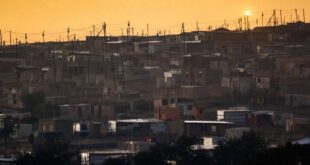The small spark – pictures of foreign beaches and cities – was a catalyst that eventually lead to extensive travel, an award-winning career and a decade’s long photography project.
“[Seeing those postcards] triggered this thought that in life there is a person who you never, ever saw – the photographer – who was part of all these great moments,” Murphy said.
“So it made me think as I was walking around the beat in the early mornings and I made the bold decision to pursue this thing called photography.”
This was back in 1998 and Murphy left his job with the Royal Mail and went to North Glasgow College to study photography.
In another stroke of good fortune, Murphy was living in Govanhill, a community in the south side of Glasgow that would become – for better and worse – one of the most hotly talked about places in Scotland.
His college assignments included portraiture and street photography so the student began walking around the area taking photographs.
It was the time of the famous Govanhill Baths occupation. Glasgow City Council shut the facility, prompting furious backlash from the community and a months-long occupation of the building that was rich fodder for a new photographer with ambitions.
A job with The Herald then followed, giving Murphy the chance to travel to some of those places he’d only seen on postcards and to even further afield: Columbia, the DRC, Rwanda, Bangladesh.
“My dream job was working for The Herald and I have huge regrets because I threw away all my negatives from that time and that was a mistake because a lot of it was early shorts from Govanhill, which are gone,” he said.
“The job for The Herald was amazing but then things got a bit shaky in the newspaper industry and my first daughter was coming along so I left and went into teaching and teaching was great and there was great but there was this hunger to create.”
That hunger led him to continue photographing Govanhill and the area’s diverse community with a more concerted street portraiture project starting in earnest seven years ago.
It is the most multi-cultural places in Scotland with as many as 60 languages spoken and the UK’s second largest Roma communities, which makes for a vibrant and culturally rich area.
To Murphy, it felt as good as being able to travel, this ability to find so many different faces on his doorstep.
His quest for subjects has led to Murphy becoming a Govanhill flaneur, walking the streets looking for curious and quirky people to capture in his black and white images.
It is, he says, all based on a feeling he gets when he sees people.
At the start of the project he put a call out on Facebook for subjects to study and said he would often receive recommendations yet when he met with people the vibe was lacking.
“Photography is all about the visual response,” he says. “So the way it works for me is I just wander. I’ll spend half a day, or a day, just walking and being very open to chance encounters.
“It could just be about the character that they have or it could be what they’re wearing or their hairstyle just to say anything really.
“It’s very hard to pinpoint.”
Govanhill is rich in characters. One day, walking through the community, Murphy spotted a young man with a very small dog on a lead – on approach, it turned out to be a ferret.
Another woman caught his eye for the ragdoll cat she had draped around her shoulders as she walked near the local park.
Making an instant connection with strangers on the street and persuade them to play for pictures is no easy task but Murphy credits his newspaper training for his ability to quickly build rapport.
“What I also realised,” Murphy said, “Was that I have to ask myself, and I think also sounds a bit cringy but I do ask myself, what is it about this person?
“Because it does come from a place of love and a sense that the person attracts me.
“I tell them exactly what it is that I love about them and there’s something that goes in those immediate seconds where an honest, completely open approach works.”
Murphy insists his work is not political, which is a bold claim to make given his aim is to soothe the social ructions caused by the melting pot of cultures in the community.
Govanhill has long been plagued by right wing media, irresponsible reporting and targeted by far right politicians who want to manipulate the narrative around migration.
Murphy has held exhibitions of his work, including in Govanhill Baths, which is undergoing a major refurbishment, but many of the subjects of his portraits didn’t attend.
He realised that not everyone feels comfortable at an art exhibition and so he set up a community-based show of exhibits in local shops and cafes.
Murphy said: “Travelling totally enriched my life. And so I think being open to people is important that way, you can only really do that as you’re looking people in the eyes.
“So my hope when I had the exhibitions in the windows was that people would look at this person’s portrait and take the chance to look at that person in the eyes.
“And that might just trigger a question or a thought that this person is not so different.
“That’s kind of what it’s about.
“If we can open up to people and let go of our fear then that’s about humanity. That’s not political.
Govanhill is no longer Murphy’s doorstep as he’s moved just outside of Glasgow but he grew up the area: his paternal grandmother and his father lived there and so he spent time in the community from early childhood. As would be expected, he spends a lot of time in the community looking for portrait subjects and can’t move without bumping into people he knows – or who know him.
An area constantly in flux, Govanhill faces endless discussions about gentrification and the future of the working class community Over the past 20 to 30 years it has undergone dramatic changes, including the explosion of a thriving, multi-cultural food and drink scene.
“The biggest change is the price of coffee,” Murphy laughs. “Back in the day, the only coffee you could get in Govanhill was in one of those polystyrene cups; granules of Nescafe that even in hot, scalding water would never disintegrate.
“But it’s a serious point too because the fact you’re now nearly £4 for a cup of coffee represents where Govanhill is now and how it has changed in the bigger picture to be trendier.”
Murphy has a new exhibition next month in Glasgow and the first book of his work is due for release – although all copies are already sold out on pre-order.
He added: “The book selling out is crazy. I haven’t even held a copy in my hands yet and it’s sold out.
“It’s a lovely way to commemorate the project, which I think of a celebration of community effort, but I’ll always be shooting in Govanhill.”


